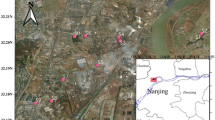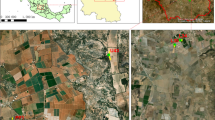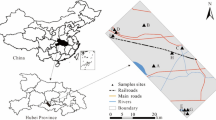Abstract
With the intensification of industrial development and urbanization, soil pollution is increasingly prominent. Therefore, the potential adverse effects caused by industrial activities need to be investigated. In this study, nine soil samples were collected from the industrial district of Nanjing, China, and the heavy metal concentrations were analyzed. Ambient severity of health (ASI) and ambient severity of ecology (ASII) caused by heavy metals in soil extracts were also evaluated via the multi-media environmental goals (MEG). The environmental risk assessment model was used to assess the health risk of soil extracts. The toxicity of soil extracts was diagnosed for wheat and Vicia faba. The results indicate that the contents of heavy metals were significantly different among the nine soil samples and mass concentration of heavy metals were as followed: Pb > Mn > As > Zn > Cd. Except for CK and S9, the total health impact of all sampling sites were greater than 1. Also, the total ecological hazard degrees of the five heavy metals were all greater than 1, which showed that the soil extracts were harmful to human health and ecological environment. According to the risk characterization model, the carcinogen risk of soil extracts was 1 to 10 orders of magnitude higher than that of non-carcinogens. Drinking water intake was the most direct and primary exposure route. In addition, the ecotoxicological results indicated that with the increase of heavy metal concentration, the activity of amylase (AMS) decreased, while the activity of peroxide (POD) increased, indicating that the soil extracts were toxic to V. faba. The micronucleus rates of V. faba root tips in the sampling soils were significantly higher compared with the control group, reflecting the higher genotoxicity. Our study provides theoretical support for the evaluation of potential health and ecological risks in this industrial district.



Similar content being viewed by others
Data availability
The data and material used or analyzed during the current study are available from the corresponding author on reasonable request.
References
Ahmad R, Ali S, Hannan F, Rizwan M, Iqbal M, Hassan Z, Akram NA, Maqbool S, Abbas F (2017) Promotive role of 5-aminolevulinic acid on chromium-induced morphological, photosynthetic, and oxidative changes in cauliflower (Brassica oleracea botrytis L.). Environ Sci Pollut Res 24:8814–8824
Arnon DI (1949) Copper enzymes in isolated chloroplasts: polyphenoloxidase in Beta vulgaris. Plant Physiol 24:1
Chapman EEV, Dave G, Murimboh JD (2012) Bioavailability as a factor in risk assessment of metal-contaminated soil. Water Air Soil Pollut 223:2907–2922. https://doi.org/10.1007/s11270-012-1074-z
Conesa HM, Wieser M, Studer B, Gonzalez-Alcaraz MN, Schulin R (2012) A critical assessment of soil amendments (slaked lime/acidic fertilizer) for the phytomanagement of moderately contaminated shooting range soils. J Soils Sediments 12:565–575. https://doi.org/10.1007/s11368-012-0478-0
Curtis T, Halford NG (2014) Food security: the challenge of increasing wheat yield and the importance of not compromising food safety. Ann Appl Biol 164:354–372. https://doi.org/10.1111/aab.12108
Dı́az J, Bernal A, Pomar F, Merino F (2001) Induction of shikimate dehydrogenase and peroxidase in pepper (Capsicum annuum L.) seedlings in response to copper stress and its relation to lignification. Plant Sci 161:179–188. https://doi.org/10.1016/S0168-9452(01)00410-1
Dong WW, Zhang Y, Quan X (2020) Health risk assessment of heavy metals and pesticides: a case study in the main drinking water source in Dalian, China. Chemosphere 242:1–13. https://doi.org/10.1016/j.chemosphere.2019.125113
Doyi I, Essumang D, Gbeddy G, Dampare S, Kumassah E, Saka D (2018) Spatial distribution, accumulation and human health risk assessment of heavy metals in soil and groundwater of the Tano Basin, Ghana. Ecotoxicol Environ Saf 165:540–546. https://doi.org/10.1016/j.ecoenv.2018.09.015
Foltête AS, Masfaraud JF, Bigorgne E, Nahmani J, Chaurand P, Botta C, Labille J, Jérôme Rose J, Férard JF, Cotelle S (2011) Environmental impact of sunscreen nanomaterials: ecotoxicity and genotoxicity of altered TiO2 nano-composites on Vicia faba. Environ Pollut 159:2515–2522. https://doi.org/10.1016/j.envpol.2011.06.020
Fu J, Hu X, Tao XC, Yu HX, Zhang XW (2013) Risk and toxicity assessments of heavy metals in sediments and fishes from the Yangtze River and Taihu Lake, China. Chemosphere 93:1887–1895. https://doi.org/10.1016/j.chemosphere.2013.06.061
Ghosh M, Singh SP (2005) A review on phytoremediation of heavy metals and utilization of its byproducts. Appl Ecol Environ Res 3:1–18
Gill RA, Zang LL, Ali B, Farooq MA, Cui P, Yang S, Ali S, Zhou WJ (2015) Chromium-induced physio-chemical and ultrastructural changes in four cultivars of Brassica napus L. Chemosphere 120:154–164. https://doi.org/10.1016/j.chemosphere.2014.06.029
Giorgetti L, Talouizte H, Merzouki M, Caltavuturo L, Geri C, Frassinetti S (2011) Genotoxicity evaluation of effluents from textile industries of the region Fez-Boulmane, Morocco: a case study. Ecotoxicol Environ Saf 74:2275–2283. https://doi.org/10.1016/j.ecoenv.2011.08.002
Giri S, Singh AK (2014) Risk assessment, statistical source identification and seasonal fluctuation of dissolved metals in the Subarnarekha River, India. J Hazard Mater 265:305–314. https://doi.org/10.1016/j.jhazmat.2013.09.067
He JY, Ren YF, Cheng Z, Jiang DA (2008) Effects of cadmium stress on seed germination, seedling growth and seed amylase activities in rice (Oryza sativa). Rice Sci 15(4):319–325
Hu BF, Shao S, Ni H, Fu Z, Hu L, Zhou Y, Min X, She S, Chen S, Huang M, Zhou L, Li Y, Shi Z (2020) Current status, spatial features, health risks, and potential driving factors of soil heavy metal pollution in China at province level. Environ Pollut 266. https://doi.org/10.1016/j.envpol.2020.114961
Hu BF, Wang JY, Jin B, Li Y, Shi Z (2017) Assessment of the potential health risks of heavy metals in soils in a coastal industrial region of the Yangtze River Delta. Environ Sci Pollut Res 24:19816–19826. https://doi.org/10.1007/s11356-017-9516-1
Iqbal M (2016) Vicia faba bioassay for environmental toxicity monitoring: a review. Chemosphere 144:785–802. https://doi.org/10.1016/j.chemosphere.2015.09.048
Jia X, Hu B, Marchant BP, Zhou L, Shi Z, Zhu Y (2019) A methodological framework for identifying potential sources of soil heavy metal pollution based on machine learning: a case study in the Yangtze Delta, China. Environ Pollut 250:601–609. https://doi.org/10.1016/j.envpol.2019.04.047
Jiang XF, Chen H, Liao YC, Ye ZQ, Li M, Göran K (2019) Ecotoxicity and genotoxicity of polystyrene microplastics on higher plant Vicia faba. Environ Pollut 250:831–838
Kerger BD, Paustenbach DJ, Corbett GE, Finley BL (1996) Absorption and elimination of trivalent and hexavalent chromium in humans following ingestion of a bolus dose in drinking water. Toxicol Appl Pharmacol 141:145–158. https://doi.org/10.1016/S0041-008X(96)80020-2
Khan I, Iqbal M, Ashraf MY, Ashraf MA, Ali S (2016) Organic chelants-mediated enhanced lead (Pb) uptake and accumulation is associated with higher activity of enzymatic antioxidants in spinach (Spinacea oleracea L.). J Hazard Mater 317:352–361. https://doi.org/10.1016/j.jhazmat.2016.06.007
Knasmüller S, Gottmann E, Steinkellner H, Fomin A, Pickl C, Paschke A, Göd R, Kundi M (1998) Detection of genotoxic effects of heavy metal contaminated soils with plant bioassays. Mutat Res 420:37–48. https://doi.org/10.1016/S1383-5718(98)00145-4
Koss G (1985) Economic methods for multipollutant analysis and evaluation: (Pollution Engineering and Technology: A Series of Reference Books and Textbooks, Vol. 25). William D. Baasel. Marcel Dekker, Inc, New York
Lin WJ, Xiao TF, Wu YY, Ao ZQ, Ning ZP (2012) Hyperaccumulation of zinc by Corydalis davidii in Zn-polluted soils. Chemosphere 86:837–842. https://doi.org/10.1016/j.chemosphere.2011.10.060
Li Z, Ma Z, Van der Kuijp TJ, Yuan Z, Huang L (2014) A review of soil heavy metal pollution from mines in China: pollution and health risk assessment. Sci Total Environ 468:843–853. https://doi.org/10.1016/j.scitotenv.2013.08.090
Ma CC, Hong FS (1998) Preliminary explanation of the mechanism about effects of mercury on wheat seed germination and seedling growth. Chin J Plant Ecol 22(4):373–378. in Chinese
Ma TH, Xu ZD, Xu CE, McConnell H, Rabago EV, Arreola GA, Zhang HE (1995) The improved Allium/Vicia root tip micronucleus assay for clastogenicity of environmental pollutants. Mutat Res 334:185–195. https://doi.org/10.1016/0165-1161(95)90010-1
Mueller KE, Polissar PJ, Oleksyn J, Freeman KH (2012) Differentiating temperate tree species and their organs using lipid biomarkers in leaves, roots and soil. Org Geochem 52:130–141. https://doi.org/10.1016/j.orggeochem.2012.08.014
Nelson DW, Sommers LE, Sparks DL, Page AL, Helmke PA, Loeppert RH, Soltanpour PN, Tabatabai MA, Johnston CT, Sumner ME (1996) Total carbon, organic carbon, and organic matter. Method Soil Anal 9:961–1010
Rodrigues SM, Henriques B, Ferreira da Silva E, Pereira ME, Duarte AC, Groenenberg JE, Romkens PFAM (2010) Evaluation of an approach for the characterization of reactive and available pools of 20 potentially toxic elements in soils: Part II—solid-solution partition relationships and ion activity in soil solutions. Chemosphere 81:1560–1570. https://doi.org/10.1016/j.chemosphere.2010.09.042
Römbke J, Jänsch S, Meier M, Hilbeck A, Teichmann H, Tappeser B (2010) General recommendations for soil ecotoxicological tests suitable for the environmental risk assessment of genetically modified plants. Integr Environ Assess Manage 6:287–300. https://doi.org/10.1897/IEAM_2009-043.1
Rucinska-Sobkowiak R, Pukacki PM (2006) Antioxidative defense system in lupin roots exposed to increasing concentrations of lead. Acta Physiol Plant 28:357–364
Shakoor MB, Ali S, Hameed A, Farid M, Hussain S, Yasmeen T, Najeeb U, Bharwana SA, Abbasi GH (2014) Citric acid improves lead (Pb) phytoextraction in Brassica napus L. by mitigating Pb-induced morphological and biochemical damages. Ecotoxicol Environ Saf 109:38–47. https://doi.org/10.1016/j.ecoenv.2014.07.033
Shi GT, Chen ZL, Bi CJ, Wang L, Teng JY, Li YS, Xu SY (2011) A comparative study of health risk of potentially toxic metals in urban and suburban road dust in the most populated city of China. Atmos Environ 45:764–771. https://doi.org/10.1016/j.atmosenv.2010.08.039
Shi M, Hou S, Sun Y, Dang H, Song Q, Jiang L, Cao W, Wang h, He X, Wang Z (2020) Regional wheat grain manganese and its potential risks affected by soil pH and precipitation. J Clean Pro 264. https://doi.org/10.1016/j.jclepro.2020.121677
Shi T, Ma J, Wu F, Ju T, Gong Y, Zhang Y, Wu X, Hou H, Zhao L, Shi H (2019) Mass balance-based inventory of heavy metals inputs to and outputs from agricultural soils in Zhejiang Province, China. Sci Total Environ 649:1269–1280. https://doi.org/10.1016/j.scitotenv.2018.08.414
Smith AH, Hopenhaynrich C, Bates MN, Goeden HM, Hertzpicciotto I, Duggan HM, Wood R, Kosnett MJ, Smith MT (1992) Cancer risks from arsenic in drinking water. Environ Health Persp 97:259–267. https://doi.org/10.1289/ehp.9297259
Song YF, Zhou QX, Song XY, Zhang W, Sun TH (2005) Evaluation of eco-toxicity of integral quality of soils. Acta Sci Circumst 26:130–134. in Chinese
Stobart AK, Grifiths WT, Ameen-Bukhari I, Sherwood RP (1985) The effect of Cd2+ on the biosynthesis of chlorophyll in leaves of barley. Plant Physiol 63:293–298. https://doi.org/10.1111/j.1399-3054.1985.tb04268.x
Strenge DL, Chamberlain PJ (1995) Multimedia environmental pollutant assessment system: exposure pathway and human health impact assessment models. Pacific Northwest National Laborator, Washington, pp. 22–30.
Sun SQ, Hu GH, Wang YZ, Li C (2006) Water environmental health risk assessment of Xiangjiang River. J Saf Environ 6:12–15. in Chinese
Ullah S, Adeel M, Zain M, Rizwan M, Irshad MK, Jilani G, Hameed A, Khan A, Arshad M, Raza A, Baluch MA, Rui YK (2020) Physiological and biochemical response of wheat (Triticum aestivum) to TiO2 nanoparticles in phosphorous amended soil: A full life cycle study. J Environ Manage 263. https://doi.org/10.1016/j.jenvman.2020.110365
US EPA. (1986) Superfund public health evaluation manual. EPA/540/1-86. US EPA, Washington DC
US EPA. (1989) Supplement risk assessment. Part 1. Guidance for public health risk assessment.
Wang C, Wang JH, Yang ZF, Mao CP, Ji JF (2013) Characteristics of lead geochemistry and the mobility of Pb isotopes in the system of pedogenic rock–pedosphere-irrigated riverwater-cereal-atmosphere from the Yangtze River delta region, China. Chemosphere 93:1927–1935. https://doi.org/10.1016/j.chemosphere.2013.06.073
Wang HF, Wu QM, Hu WY, Huang B, Dong LR, Liu G (2018) Using multi-medium factors analysis to assess heavy metal health risks along the Yangtze River in Nanjing, Southeast China. Environ Pollut 243:1047–1056. https://doi.org/10.1016/j.envpol.2018.09.036
Wang JH, Li SW, Cui XY, Li HM, Qian X, Wang C, Sun YX (2016) Bioaccessibility, sources and health risk assessment of trace metals in urban park dust in Nanjing, Southeast China. Ecotoxicol Environ Saf 128:161–170. https://doi.org/10.1016/j.ecoenv.2016.02.020
Wu X, Cai Q, Xu Q, Zhou Z, Shi J (2020) Wheat (Triticum aestivum L.) grains uptake of lead (Pb), transfer factors and prediction models for various types of soils from China. Ecotoxicol Environ Saf 206. https://doi.org/10.1016/j.ecoenv.2020.111387
Xia XH, Chen X, Liu RM, Liu H (2011) Heavy metals in urban soils with various types of land use in Beijing, China. J Hazard Mater 186:2043–2050. https://doi.org/10.1016/j.jhazmat.2010.12.104
Xie XJ, Zhou QX, He ZC, Bao YY (2010) Physiological and potential genetic toxicity of chlortetracycline as an emerging pollutant in wheat (Triticum aestivum L.). Environ Toxicol Chem 29:922–928
Yang TS, Zheng XL, Xu YY, Zou YJ, Ma YJ, Li M (2008) Health-hazard assessment for the urban water supply sources in Huangdao District of Qingdao. J Saf Environ 8:83–86. in Chinese
Yang Y, Li Y, Chen W, Wang M, Wang T, Dai Y (2020) Dynamic interactions between soil cadmium and zinc affect cadmium phytoavailability to rice and wheat: Regional investigation and risk modeling. Environ Pollut 267. https://doi.org/10.1016/j.envpol.2020.115613
Zegzouti Y, Aguelmous A, Khadra A, Boutafda A, El Fels L, Hassani LAI, El Hadek M, Hafidi M (2020) Genotoxicity evaluation of different types of leachate treated with Aspergillus flavus using Vicia faba micronucleus. Environ Technol Innov 18. https://doi.org/10.1016/j.eti.2020.100656
Zhang DJ, Jiang LN, Shao Y, Li ZH, Li CX (2009) Differential responses in germination and antionxidant enzymes of three wheat cultivars to chromium stress. Acta Agric Boreali-Sin 24:69–73. in Chinese
Zhao LY, Gong DD, Zhao WH, Lin L, Yang WJ, Guo WJ, Tang XQ, Li QY (2020) Spatial-temporal distribution characteristics and health risk assessment of heavy metals in surface water of the Three Gorges Reservoir, China. Sci Total Environ 704. https://doi.org/10.1016/j.scitotenv.2019.134883
Zhao L, Xu YF, Hou H, Shangguan YX, Li FS (2014) Source identification and health risk assessment of metals in urban soils around the Tanggu chemical industrial district, Tianjin, China. Sci Total Environ 468:654–662. https://doi.org/10.1016/j.scitotenv.2013.08.094
Zhao X, Li TY, Zhang TT, Luo WJ, Li JY (2017) Distribution and health risk assessment of dissolved heavy metals in the Three Gorges Reservoir, China (section in the main urban area of Chongqing). Environ Sci Pollut Res 24:2697–2710. https://doi.org/10.1007/s11356-016-8046-6
Funding
This research was supported by National Natural Science Foundation of China (No. 41773115, 41571468), Science and Technology Support Program of Jiangsu Province (No. BE2012737, BE2016736).
Author contributions
YF: investigation, methodology, resources, software, writing–original draft, writing–review and editing. FL: data curation, formal analysis, methodology, resources, Software, visualization. XY: visualization, methodology, writing–review and editing. YC: conceptualization, methodology, supervision. XJ: investigation, visualization, methodology, writing–review and editing. ML: conceptualization, data curation, funding acquisition, methodology, project administration, supervision, validation, writing–review and editing.
Author information
Authors and Affiliations
Corresponding authors
Ethics declarations
Conflict of interest
The authors declare that they have no conflict of interest.
Consent to participate
Informed consent was obtained from all individual participants included in the study.
Consent for publication
The participant has consented to the submission of the case report to the journal.
Ethical approval
This article does not contain any studies with human participants or animals performed by any of the authors.
Additional information
Publisher’s note Springer Nature remains neutral with regard to jurisdictional claims in published maps and institutional affiliations.
Supplementary information
Rights and permissions
About this article
Cite this article
Feng, Y., Liu, F., Li, M. et al. Risk assessment and ecotoxicological effects of leachates extracted from industrial district soils of Nanjing, China. Ecotoxicology 30, 1343–1353 (2021). https://doi.org/10.1007/s10646-020-02330-0
Accepted:
Published:
Issue Date:
DOI: https://doi.org/10.1007/s10646-020-02330-0




